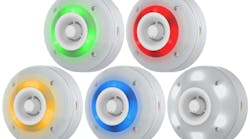There are certain features that standalone access controls sometimes leave to be desired. They’re designed with a particular set of features, and they perform those jobs really well. But the client needs it to do a little bit more or a security breach will be discovered after the fact. Combining a PG30 alarm with a Trilogy Lock results in a highly effective security cocktail.
Forced door and propped door alarms are examples. Whether you have a key lock or a keypad on a door, it is sometimes important to be able to sound an alert that a door has been forced open, left open or has not been locked properly.
Even when there is a premises alarm installed, it is sometimes advantageous to implement local security measures that are separate from the main alarm system so that the exact function can be achieved without involving additional departments and vendors.
In environments where certain doors remain unlocked and unguarded during business hours while others need to be frequently armed and disarmed by authorized individuals, separate standalone annunciators are the ideal answer, and the Alarm Lock PG30 MS is an ideal annunciator.
Many situations arise where a door is added or a security breach is discovered. Maybe the door is in a remote building, or it is not feasible to run wire to it. Maybe it is an urgent requirement and time is of the essence.
The PG30 is a keypad-operated, surface-mounted, microprocessor-controlled door alarm. The PG30 Alarm can be battery operated, standalone, and not required to be hard wired. The unit is mounted on the interior side of the door. The PG30 can be mounted on the door, or on the frame, and the handing is easily changed in the field.
This alarm is activated when the magnetic field between the main unit and actuator is interrupted. Opening the door, removal of cover or attempting to use a second magnet to defeat the device will activate the alarm.
The PG30 MS has a keypad so that a lock cylinder is not required. The unit can be actuated with a rim cylinder which would be mounted on the opposite side of the door. In the case where your customer wanted outside key control, you would be best advised to mount the PG30 chassis on the door and drill the door to mount the rim cylinder. Drilling through the frame would probably be rough going.
But then there are other options. With the PG 30 you have plenty of options. That is what makes this little unit so handy.
You can mount the PG30 on a wall, and use an external door position sensor. Then mounting a rim cylinder through the wall would be a little easier than drilling the door frame, assuming you‘re in a sheet rock wall.
If you do not want a cylinder at all, AlarmLock has a wall mount keypad option (PG30KPD) which connects with a ribbon cable to the main PG30 chassis for this purpose.
The PG 30 can be deployed to provide strategic monitoring and annunciation. The applications are almost endless.
I recently offered one to a woman who needed to comply with the building code for her backyard pool. She needed to know if the back door was opened in case it was her kids doing so without adult supervision.
In another situation, a side door of a fitness gym needed something to deter thefts and unauthorized use of the door.
Storerooms and doors in daycares and clinics need audibles. When combined with video surveillance, the PG30 provides the right amount of deterrence with detection which dovetails nicely with the rest of the security management solution.
The PG30 has three security levels to allow for different requirements. It also has an entry and exit delay. All functions are programmable to fit your job.
The unit can be set up to forgive brief openings and closings of the door without an alarm occurring. Or it can be programmed to require a code to be entered before opening the door to avoid an alarm. The unit can be set to reset itself if it alarms, or to require a master code to reset it. The unit can be programmed so that employees cannot turn it off or deactivate it. If they attempt to remove the cover, it will alarm.
The unit can be programmed so that once it has been bypassed with a code, the subject door can remain open indefinitely until the door again recloses, at which time the PG30 re-arms itself automatically.
The PG30 has three siren choices: sweep, steady and pulse. Therefore, if you have a few of them installed, you can pinpoint which one is alarming.
There are two alarm volume levels available. I’ve been involved in installations where loud audible alarms would cause patients to panic and injure themselves and the orderlies and nurses. They’d have to send in teams to medicate them and restrain them until things calmed down. A low volume alarm is sometimes a good thing.
PG30 alarm has a two-minute shutdown with automatic reset when that function is activated. This saves batteries and also saves the guard a trip to the door. In manned facilities, the guard will typically check every door numerous times during a shift. By proper wiring, the PG30 will remain in alarm if the door is not properly locked after an alarm has occurred.
Power is provided by a 9-volt alkaline battery. The life cycle of the battery depends on how often the unit alarms, but it will last for quite a while, and the PG30 has a low battery alert.
LED will flash once every four hours to indicate battery status. The unit will chirp and LED will flash once per minute to indicate the need for battery replacement.
The PG30 can allow for continuous power with the addition of an external power supply.
Pairs of doors or multiple door monitoring is possible with built-in and external reed switches.
Remote monitoring and annunciation is possible with the supplied Form C relay output for remote monitoring and connection to fire/burglar alarm panel.
I’ve used PG30s on perimeter doors and ran power and signal lines to each one. A central panel powered them and each PG30 was represented on the alarm panel (a NAPCO of course). This enabled the guard to pinpoint the alarm location and dispatch directly to that spot. We also tied in cameras so an alarm triggered a camera preset.
Applications have included loading docks, back doors to delis, tape libraries, electrical closets. Stairwell doors, grandma’s bedroom.
Even where networked access control is present, the PG30 serves well as a local smart security device and local alarm, having the features and flexibility to be adapted to just about any application.
Did we mention that the PG30 is built like a brick and will last forever?
The PG 30 comes in a variety of finishes, and also configured for use with lock cylinders.
The PG 30 is an exit alarm, and does not perform any locking functions, but Alarm Lock has a broad selection locks with alarms too.
For more information, contact your local locksmith distributor or Alarm Lock, 345 Bayview Ave., Amityville, NY 11701. Phone: 800-252-5625. Web Site: www.alarmlock.com
Related
Related
Electronics & Access Control
Alarm Lock Systems
July 10, 2017





